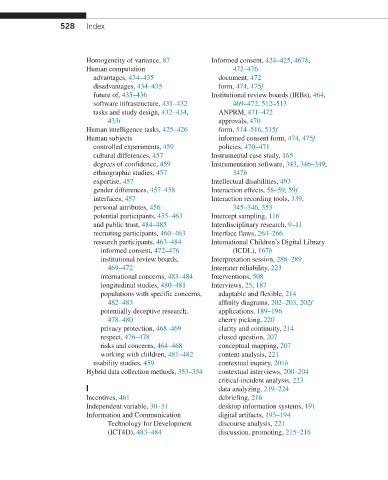Page 535 -
P. 535
528 Index
Homogeneity of variance, 87 Informed consent, 424–425, 467b,
Human computation 472–476
advantages, 434–435 document, 472
disadvantages, 434–435 form, 474, 475f
future of, 435–436 Institutional review boards (IRBs), 464,
software infrastructure, 431–432 469–472, 512–513
tasks and study design, 432–434, ANPRM, 471–472
433t approvals, 470
Human intelligence tasks, 425–426 form, 514–516, 515f
Human subjects informed consent form, 474, 475f
controlled experiments, 459 policies, 470–471
cultural differences, 457 Instrumental case study, 165
degrees of confidence, 459 Instrumentation software, 343, 346–349,
ethnographic studies, 457 347b
expertise, 457 Intellectual disabilities, 493
gender differences, 457–458 Interaction effects, 58–59, 59f
interfaces, 457 Interaction recording tools, 339,
personal attributes, 456 345–346, 353
potential participants, 455–463 Intercept sampling, 116
and public trust, 484–485 Interdisciplinary research, 9–11
recruiting participants, 460–463 Interface flaws, 264–266
research participants, 463–484 International Children’s Digital Library
informed consent, 472–476 (ICDL), 167b
institutional review boards, Interpretation session, 288–289
469–472 Interrater reliability, 223
international concerns, 483–484 Interventions, 508
longitudinal studies, 480–481 Interviews, 25, 187
populations with specific concerns, adaptable and flexible, 214
482–483 affinity diagrams, 202–203, 202f
potentially deceptive research, applications, 189–196
478–480 cherry picking, 220
privacy protection, 468–469 clarity and continuity, 214
respect, 476–478 closed question, 207
risks and concerns, 464–468 conceptual mapping, 207
working with children, 481–482 content analysis, 221
usability studies, 459 contextual inquiry, 201b
Hybrid data collection methods, 353–354 contextual interviews, 200–204
critical-incident analysis, 223
I data analyzing, 219–224
Incentives, 461 debriefing, 216
Independent variable, 30–31 desktop information systems, 191
Information and Communication digital artifacts, 193–194
Technology for Development discourse analysis, 221
(ICT4D), 483–484 discussion, promoting, 215–216

